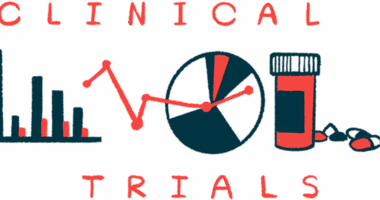Hemlibra (emicizumab-KXWH) for hemophilia
What is Hemlibra for hemophilia?
Hemlibra (emicizumab-KXWH) is an antibody-based therapy used to prevent or reduce bleeds in hemophilia A patients, with or without factor VIII (FVIII) inhibitors. It is given as an under-the-skin, or subcutaneous, injection.
The therapy was originally developed by Chugai Pharmaceutical, which is now part of the Roche group. Further development and marketing are being conducted in collaboration with Genentech, a Roche subsidiary.
Therapy snapshot
| Brand name: | Hemlibra |
| Chemical name: | Emicizumab-KXWH |
| Usage: | Prevention of bleeding episodes in people with hemophilia A |
| Administration: | Subcutaneous injection |
How does Hemlibra work?
Hemophilia A is an inherited bleeding disorder, caused by a mutation in the gene encoding FVIII, an essential blood-clotting protein. Normally, this protein binds to both factor IX (FIX) and factor X (FX) to initiate blood clotting. A deficiency in FVIII can cause excessive and prolonged bleeding.
Hemlibra is a bispecific antibody designed to bind to two targets — FIX and FX — mimicking the action of FVIII, and thereby preventing or lowering the frequency of bleeding episodes in people with hemophilia A. The medication is also effective in patients with FVIII inhibitors, which are neutralizing antibodies targeting FVIII that might render standard replacement therapies ineffective.
Who can take Hemlibra?
Hemlibra was initially approved by the U.S. Food and Drug Administration (FDA) in November 2017 to prevent or reduce the frequency of bleeding episodes in children and adults with hemophilia A with FVIII inhibitors. Its approval was extended in the U.S. in October 2018 to hemophilia A patients without FVIII inhibitors.
In the European Union, the therapy was initially approved as a preventive treatment for hemophilia A patients with inhibitors (in 2018) or without (in 2019) who have severe disease — those having less than 1% residual FVIII activity. This was later expanded to include those with moderate disease, or those with 1%-5% of normal FVIII activity.
Hemlibra has been approved in Japan as a preventive treatment for both congenital (inherited) and acquired hemophilia A. The therapy is also cleared to treat hemophilia A patients with inhibitors in more than 100 other countries.
Who should not take Hemlibra?
According to the therapy’s prescribing information, there are no contraindications for its use.
However, Hemlibra’s label has a boxed warning about the risk of thrombotic microangiopathy (a condition caused by the formation of microscopic blood clots in small blood vessels) and thrombotic events (when blood clots block blood vessels). People receiving the therapy should therefore be monitored for these types of events, and treatment should be discontinued if symptoms occur.
How is Hemlibra administered?
Hemlibra is given as a subcutaneous injection, and is available in single-dose bottles containing one of the following strengths:
- 12 mg/0.4 mL, contained in a vial with a gray cover
- 30 mg/mL, contained in a vial with a sky blue cover
- 60 mg/0.4 mL, contained in a vial with a purple cover
- 105 mg/0.7 mL, contained in a vial with a turquoise blue cover
- 150 mg/mL, contained in a vial with a brown cover
- 300 mg/2 mL, contained in a vial with a yellow cover.
The recommended loading dose is 3 mg/kg of body weight once every week for the first month, followed by a maintenance dose of:
- 1.5 mg/kg once every week, or
- 3 mg/kg once every two weeks, or
- 6 mg/kg once every four weeks.
The therapy should only be used under the supervision of a healthcare professional. Injection may be self-administered by patients or given by caregivers, but always after proper training. Self-injection is not recommended for children younger than 7.
Patients should rotate the injection site. Parts of the body that can receive the injection include the upper outer arms (only given by a caregiver or healthcare provider), thighs, and abdomen. Skin areas that are irritated, reddened, bruised, infected, or scarred should be avoided.
Hemlibra should be stored in the fridge, and should not be frozen or shaken. To protect the medication from light, vials should be kept inside their original carton until use. Unopened bottles can be stored up to seven days at room temperature and never at a temperature greater than 86 degrees Fahrenheit (30 degrees Celsius). Vials should be taken out of the fridge 15 minutes before injection to allow the medication to reach room temperature prior to administration.

Hemlibra in clinical trials
Hemlibra’s original approval came on the heels of positive results from two of the largest clinical studies in hemophilia A patients with FVIII inhibitors, the HAVEN 1 and HAVEN 2 trials. The HAVEN 3 and HAVEN 4 trials supported the therapy’s approval for patients without FVIII inhibitors.
A pooled analysis of the HAVEN 1-4 studies supported the long-term efficacy and tolerability of Hemlibra in children, adolescents, and adults.
HAVEN 1 trial
The open-label Phase 3 trial HAVEN 1 (NCT02622321) assessed the safety and efficacy of weekly Hemlibra for preventing bleeds (prophylaxis) in 113 patients, 12 and older, with inhibitors. Those who had previously been treated with bypassing agents were randomly assigned to receive Hemlibra prophylaxis (group A) or no prophylaxis (group B). Patients who had previously received prophylactic treatment with bypassing agents received Hemlibra prophylaxis in group C.
Patients receiving prophylactic treatment with Hemlibra saw their annual bleeding rate drop by 87% compared with those not receiving the preventive medicines. Patients in group C also saw their annual bleeding rate drop by 79% while on Hemlibra compared with their previous prophylactic regimen with bypassing agents.
HAVEN 2 trial
HAVEN 2 (NCT02795767) was also a multicenter, open-label Phase 3 trial which enrolled 88 patients younger than 12 who had inhibitors. Results showed that 77% of children who received Hemlibra prophylaxis had zero treated bleeds. Also, all joint bleeding episodes resolved during the study period. In an intra-patient analysis of 15 children, Hemlibra prophylaxis resulted in a 99% reduction in treated bleeds compared with previous treatment with a bypassing agent (given either as prophylactic or on-demand treatment).
HAVEN 3 trial
Launched in 2016, HAVEN 3 (NCT02847637) evaluated Hemlibra prophylaxis in 152 severe hemophilia A patients, 12 and older, without FVIII inhibitors. Results of this trial showed a significant reduction in the number of bleeds in Hemlibra-treated patients with once- or twice-weekly dosing compared with those who did not receive prophylaxis. The study also showed that Hemlibra prophylaxis was better than FVIII prophylaxis at reducing bleeding rates.
HAVEN 4 trial
The HAVEN 4 (NCT03020160) study assessed the efficacy and safety of Hemlibra prophylaxis given at a reduced rate — 6 mg/kg every four weeks — in 48 male adults and adolescents with hemophilia A with or without inhibitors. Data overall supported this once-monthly dosing schedule. The annualized treated bleed rate was 2.4, with more than half of participants reporting no treated bleeds, and about 90% with fewer than three treated bleeds.
HAVEN 5 trial
HAVEN 5 (NCT03315455) enrolled 70 patients, 12 and older, in Asia to further investigate the efficacy, safety, and pharmacological properties of Hemlibra regardless of inhibitor status. Results indicated that Hemlibra was an effective treatment at either one of two doses — 1.5 mg/kg once weekly or 6 mg/kg every four weeks — over at least six months of treatment.
STASEY trial
The STASEY Phase 3 trial (NCT03191799) was launched in 2017 to evaluate the long-term safety and tolerability of once-weekly preventive Hemlibra treatment in 195 hemophilia A patients, 12 and older, with inhibitors. As in earlier trials, Hemlibra was found to safely and effectively lower the number of bleeds over up to two years of treatment.
Ongoing trials
HAVEN 6 (NCT04158648) is evaluating Hemlibra among 73 patients with mild or moderate hemophilia A (non-severe disease) in the U.S. and Europe. Primary data analysis indicated that the therapy was safe and could effectively prevent bleeds in these patients, with 67% of participants having no treated bleeds. HAVEN 6 is expected to finish in 2025.
The HAVEN 7 trial (NCT04431726) is investigating the benefits of Hemlibra in 55 infants, from newborns to 1 year olds, with hemophilia A. Interim analyses showed that the therapy was safe and effective with nearly half (42.6%) of the babies not experiencing any bleeds. HAVEN 7 is set to finish in 2030.
Common side effects of Hemlibra
The most common side effects associated with Hemlibra are:
- injection site reactions
- headache
- arthralgia, or joint pain.
Other, less common side effects should also be taken into consideration, namely blood clots and blood vessel damage.
Blood clots
Thrombotic, or blood clotting, events have been reported in patients on Hemlibra who were also given an activated prothrombin complex concentrate (aPPC; sold as FEIBA) to control bleeds. Hemlibra can also interfere with certain blood clotting tests. Prophylactic treatment with Hemlibra should be interrupted and FEIBA should be discontinued immediately if blood clotting signs occur. Restarting treatment with Hemlibra after symptom resolution should only be considered after assessing the benefits and risks on a patient-by-patient basis.
Blood vessel damage
The FDA label has a boxed warning alerting healthcare professionals and patients that Hemlibra may cause thromboembolism (blood vessel obstruction due to blood clots) and thrombotic microangiopathy (TMA) — a condition in which blood clots cause damage to small blood vessels — when used together with FEIBA, particularly at a cumulative dose greater than 100 units/kg/day for more than one day. As with blood clots, in the presence of TMA signs, FEIBA should be discontinued and Hemlibra prophylaxis interrupted. Once these signs resolve, patients may resume treatment after considering the benefits and risks.
Development of antibodies
Development of antibodies against Hemlibra may occur during treatment. In some cases, this is related to a reduction in the treatment’s efficacy. The therapy’s label recommends monitoring for signs of efficacy loss. If antibodies are suspected, other treatments should be considered.
Use in pregnancy and breastfeeding
It is unknown if Hemlibra can affect the developing fetus or pass to breast milk. Patients who plan to become pregnant or to breastfeed should talk with their healthcare team and only continue treatment during these periods if the potential benefit justifies the potential risks to the fetus or infant.
Hemophilia News Today is strictly a news and information website about the disease. It does not provide medical advice, diagnosis, or treatment. This content is not intended to be a substitute for professional medical advice, diagnosis, or treatment. Always seek the advice of your physician or other qualified health provider with any questions you may have regarding a medical condition. Never disregard professional medical advice or delay in seeking it because of something you have read on this website.
Recent Posts
- When scars from my IV infusions lead to false assumptions
- Blood immune markers may predict ITI response in hemophilia A
- Going back to basics and finding strength on the floor
- Hympavzi lowers bleeding rates for hemophilia patients with inhibitors
- How our oldest son and hemophilia entered our lives, part 2
Related articles

 Fact-checked by
Fact-checked by 



